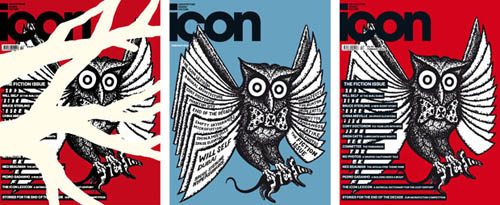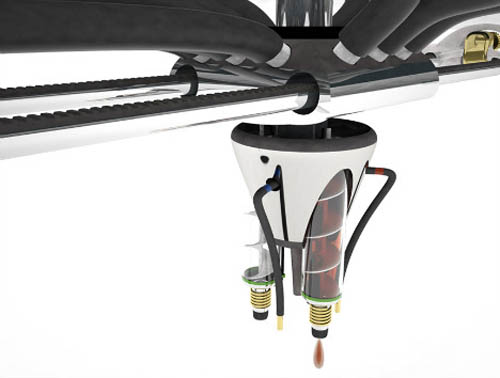I was excited finally to pick up a copy of Icon’s February issue today; it is, in its entirety, an exploration of how fiction can be used to explore architectural ideas and the future of the built environment.

Contributors range from China Miéville, Bruce Sterling, and Cory Doctorow to Ned Beauman, Alexandra Daisy Ginsberg & Oron Catts, and Will Self, with microfiction contributions from Tim Maly of Quiet Babylon fame and Simon Sellars of Ballardian. I was also very happy to see that “Landscapes of Quarantine” participant Scott Geiger appears with a short review, and there is much else besides.
China Miéville’s story, “The Rope is the World,” takes place amidst “the space elevators, the skyhooks, the geostationary tethered-dock haulage columns” of a planet bound to its lower atmosphere by giant pieces of astral infrastructure. However, these elevators, in Miéville’s telling, are doomed to become fantastic aerial ruins, turning the Earth into “an irregularly spoked wheel” studded with abandoned elevator shafts, each “longer than Russia.” Derelict chain-cities hang flaccid in the skies. What might Caspar David Friedrich have painted in such a world?
Bruce Sterling, meanwhile, presents us with a world in which nothing seems to exist but broadband access—and that world is far from exhilarating. The story’s accompanying photograph shows us a Windows-powered laptop sitting alone on a plaster-flecked apartment floor, plugged into the wall of a room that otherwise has nothing in it; this solipsistic interior, void of anything like human presence or culture, reminded me of an old Peter Lamborn Wilson interview in which Wilson launches into an amazing rant against the rise of home internet use (even if I don’t agree with his conclusions):
Yes. You’re slumped in front of a screen, in the same physical situation as a TV watcher, you’ve just added a typewriter. And you’re “interactive.” What does that mean? It does not mean community. It’s catatonic schizophrenia. So blah blah blah; communicate communicate; data data data. It doesn’t mean anything more than catatonics babbling and drooling in a mental institution. Why can’t we stop?
In Sterling’s fictional world, these empty interiors freed of all personal possessions, with not even a place to sit, pulsate with instant access to Gmail; you can check your Twitter feed even if you can’t cook a decent meal.
But when the story’s protagonist obtains a mail-order 3D printer (“This sleek and sturdy overnight parcel contains everything one might need for do-it-yourself, open-source digital home fabrication,” Sterling writes), he or she gains an ability to produce objects—which then seems to be greeted with hipster disillusionment, rather than with ecstasy.
Indeed, the story ends on a low note; its final line: “I have to print my bed, so that I can lie in it.”
I have to admit to having already read that final sentence courtesy of Matt Jones’s Twitter feed a few weeks ago, and I had imagined, between then and now, a totally different story. I had pictured Sterling’s story, called “The Hypersurface of the Decade,” set in a world where personalized 3D printers create everything from our furniture to our food; today we might print our boarding passes at home before getting on an airplane, but tomorrow we will print our hamburgers, TVs, and even bedspreads.
Maybe we’ll print dogs and subway passes and prescription medications. Maybe we will even print our children.

[Image: MIT’s Fluid Interfaces Group’s Cornucopia 3D food-printer].
Maybe it’s just a question of having the right new infrastructure of pipes—no, not those pipes. Maybe we need to forget ink cartridges; we’ll just subscribe to personal flows of speciality ingredients, chemical mixtures that come to us through a radically retooled infrastructure of pipes embedded in the walls of our cities. As unsurprising to someone in 50 years as piped water is to residents of New York today, anyone will simply print a pill of Prozac when they really need it or even print themselves a birthday cake.
Forget killer apps; all you need is the right printhead. Plug it into a nozzle on the wall and voilà.
In any case, I had pictured a story set in some strange Dr. Seuss world of instantly-printed objects. Forget furniture and clothing and utensils. Forget the Apple Tablet; instead you’d carry portable printheads, emitting on-demand, dissolvable realities of the present moment. Trapped in a room, you’d simply print a hammer and attack the wall. Of course, in many ways that is exactly what Sterling has described in his story, but it takes till the last three or four paragraphs to get a glimpse of this malleable world.
But, speaking only for myself, I’d love to spend more time inside this strange fever-dream in which instantly realizable objects appear left and right. I would hold something not unlike a gateway in my hand—some fabulous new printhead—spraying forms into the world of human beings.
Pick up a copy of Icon’s Fiction Issue before it disappears.